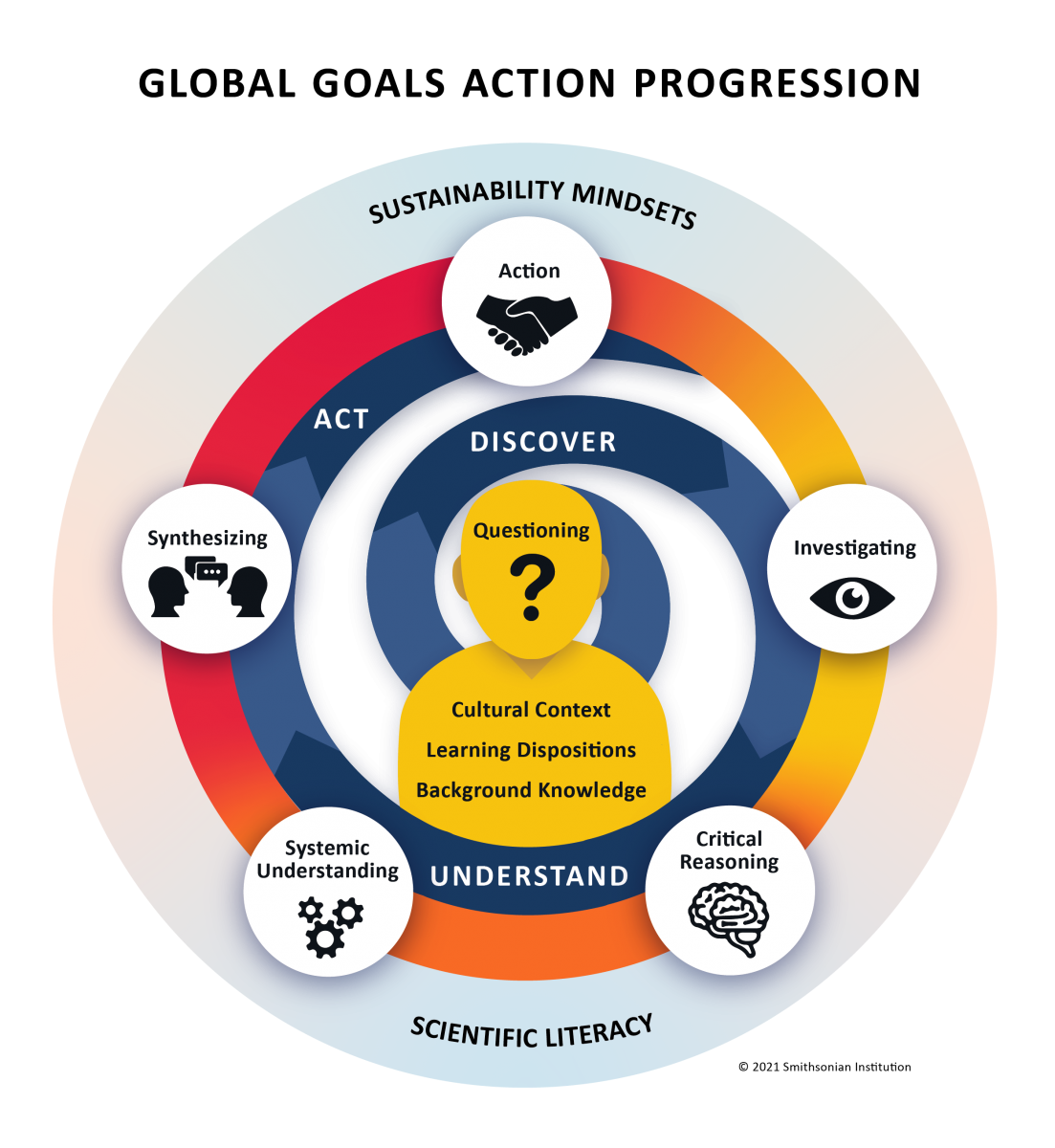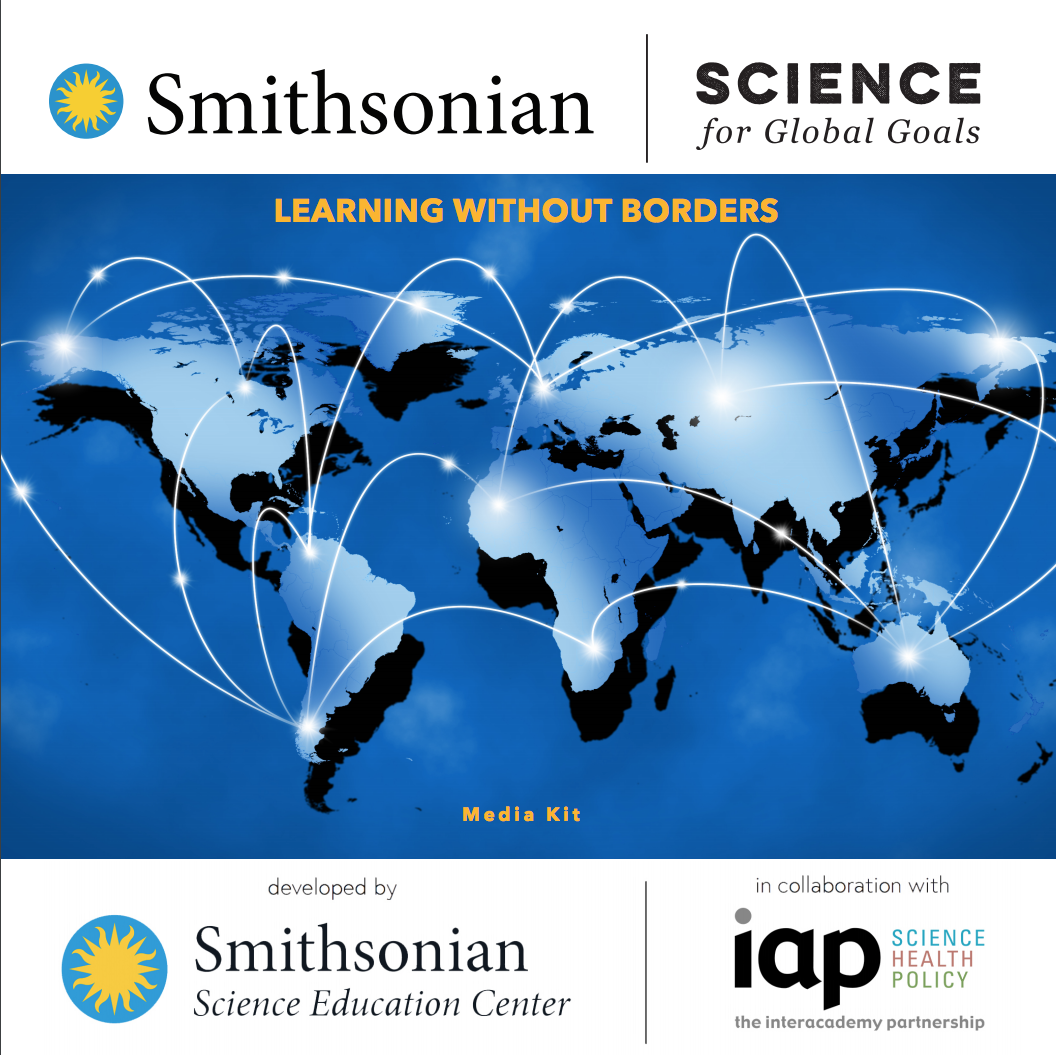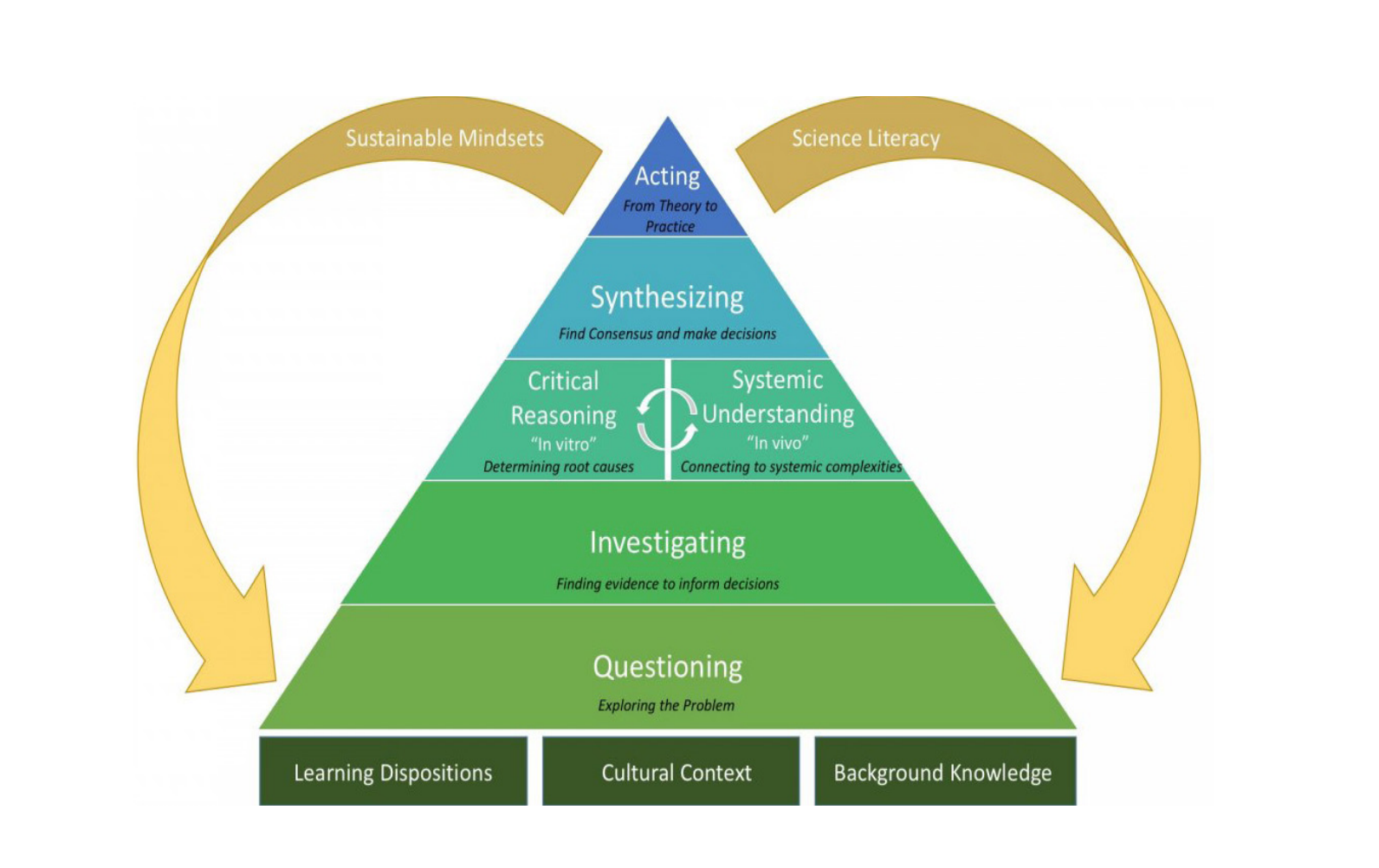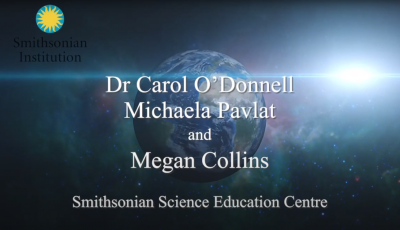Smithsonian Science for Global Goals Research
Global Goals Action Progression
The Global Goals Action Progression (or Global GAP) supports young people to form a habit of taking local action on global issues. Actions are based on students’ scientific understanding of the issue, and after careful investigation of how this issue manifests in their own local community. Along the way, they also examine issues through multiple lenses: Social, Economic, Environmental, and Ethical. The result is a progression that takes young people from understanding their own identity and the identity of their community, to questioning and investigating, to engaging in critical reasoning and developing systemic understanding. In this important phase, young people examine their own values and perspectives, and reflect on how their perspective changes as they learn more about the world around them. Ultimately young people synthesize all that they have learned and put their new knowledge to use by taking action. Through this process, young people develop sustainability mindsets, and become scientifically literate.


If you are interested in supporting the development or implementation of Smithsonian Science for Global Goals to increase our impact and reach, please see our storymap and contact the SSEC Division for Advancement and Partnerships at [email protected].
Sustainability Mindsets
The Sustainability Mindsets, pictured here, are what young people will take away from engaging in Smithsonian Science for Global Goals materials, and progressing through the Global Goals Action Progression. These mindsets are foundational for young people as they become the change makers, leaders, informed humans guiding future generations.


Learn more about Smithsonian Science for Global Goals by downloading our media kit.
Additional Reading and Research
To learn more about Smithsonian Science for Global Goals, and our approach to STEM Education for Sustainable Development, please refer to our recent publications:
- Alberts, B. (2022). Why science education is more important than most scientists think. Federation of European Biochemical Societies (FEB) Letters, 596, p. 149–159. Available: https://febs.onlinelibrary.wiley.com/doi/epdf/10.1002/1873-3468.14272
- Blanchard, K. P., Gibson, H., & O’Donnell, C. (2019). Understanding yourself as a foundation for exploring the world. In Andy Smart, Margaret Sinclair, Aaron Benavot, Jean Bernard, Colette Chabbott, S. Garnett Russell, and James Williams (Eds): NISSEM Global Briefs: Education for the Social, the Sustainable and the Emotional.
https://www.nissem.org/globalbriefs
With a focus on helping learners understand the United Nation’s Sustainable Development Goals (SDGs), this chapter argues that in order for learners to gain the knowledge and skills needed to promote sustainable development, learners need to develop a sense of identity. In other words, the authors assert that through the exploration of personal, local, and global identities, young learners can see themselves both as part of collectives within their own local communities and as members of the global citizenry, allowing young learners to be active participants with issues that impact our planet. - Dossick, A. (2022). A Case Study Exploring How the Zero Barriers in STEM Education Professional Development Program Affects Attitudes and Confidence Toward Teaching STEM Content to Students With Disabilities. Virginia Commonwealth University: Dissertation. Available: https://scholarscompass.vcu.edu/etd/7076/
- Gibson, Heidi. “Education to Create a Sustainable Future.” SmithsonianMag.com. Smithsonian Institution, February 15, 2022.
https://www.smithsonianmag.com/blogs/smithsonian-education/2022/02/15/education-to-create-a-sustainable-future/
This blog post suggests that the core of education is a goal to create a better future for learners and for us all. The post maps the journey and approach used by Smithsonian Science for Global Goals to help students develop the skills and knowledge needed to become active participants in creating a more sustainable world. - Gibson, H. (2021). From Ideas to Action: Transforming Learning to Inspire Action on Critical Global Issues. Open Monographs. Washington, DC: Smithsonian Institution Scholarly Press. Book. https://doi.org/10.5479/si.15173715.v1.
https://smithsonian.figshare.com/articles/book/
From_Ideas_to_Action_Transforming_Learning_to_Inspire_Action_on_Critical_Global_Issues/15173715/1
From Ideas to Action articulates the theoretical basis of Smithsonian Science for Global Goals, a series of socio-scientific community research guides focused on achieving a systemic understanding of global problems with the goal of inspiring young people to take informed and sustained action to help address global issues. - Gibson, H., Blanchard, K. P., O’Donnell, C. (2020). Learning to act: Smithsonian Science for Global Goals and empowering young people to develop a habit of considered action-taking. In Huber, T., O’Meara, J. (Eds.), Education around the globe: Creating opportunities and transforming lives. Charlotte, NC: Information Age Publishing.
https://www.infoagepub.com/products/Education-Around-the-Globe
This chapter provides an overview of Smithsonian Science for Global Goals, discussing the ways in which the SSfGGs project provides a learning model for guiding young people to take action, a requirement for the realization of the UN’s Sustainability Development Goals (SDGs). By proposing several action-oriented frameworks, the authors emphasize not just the importance of seeing young people as partners in solving SDG-related issues, but also the necessity of providing young people with the skills they need to be change agents. - Gibson H, Short ME, & O’Donnell C. (2023). Data, discourse, and development: Building a sustainable world through education and science communication. Frontiers in Communications, 8:981988. Retrieved from:
https://www.frontiersin.org/articles/10.3389/fcomm.2023.981988/full - Lundell, J., Borde, B., Filtzinger, B., Hansen, H., Henke, N., Oberthür, J., O’Donnell, C., Pahnke, J., Pasquinelli, E., Sadadou, D., & Vogel, A.-C. (2023). How can networks help encourage the development and professionalisation of innovative early STEM Education in a changing world?. LUMAT-B: International Journal on Math, Science and Technology Education, 8(1), 60–95. Retrieved from
https://journals.helsinki.fi/lumatb/article/view/1988 - National Academy of Sciences of Argentina. (2021). Catalyzing STEM Education and Public Engagement through the IANAS Science Education Program. Inter-American Network of Academies of Sciences (IANAS).
https://www.interacademies.org/sites/default/files/2021-09/libro-IANAS_-STEM.pdf
This report is designed to motivate and support scientists, science educators, and members of IANAS Academies Science Education Programme (SEP) Focal Points to: engage in STEM education and outreach with schools, communities, and local governments and policy-makers; support organizations that are dedicated to these pursuits; and continue the collaborative approach that resulted in this statement. Dr. Carol O'Donnell contributed to this report. Several of the examples provided in the recommendations are based on the work of the Smithsonian Science Education Center. - National Academies of Sciences, Engineering, and Medicine 2022. Taking Stock of Science Standards Implementation: Proceedings of a Virtual Summit. Washington, DC: The National Academies Press.
https://doi.org/10.17226/26549
This proceeding has been published by the National Academies of Sciences, Engineering, and Medicine amd chronicles the presentations and discussions at the October 2021 workshop, "Taking Stock of Science Standards Implementation" convened by the National Academies. The Director of the Smithsonian Science Education, Dr. Carol O'Donnell, contributed to the conversation about "High Quality Instructional Materials" and her contributions are summarized in Chapter 7. The examples provided in the quotes are based on the work of the Smithsonian Science Education Center curriculum development team. - O'Donnell, C. (2021). Discover, Understand, Act: A STEM Education Framework for Empowering Youth to Address the Global Goals. Diplomatic Courier, UNGA 2021 Special Print Edition.
https://www.diplomaticourier.com/posts/a-stem-education-framework-for-empowering-youth-to-address-the-global-goals - O'Donnell, C. (2018). Empowering Youth through the Global Goals.
https://www.diplomaticourier.com/posts/empowering-youth-through-the-global-goals
This article emphasizes the critical nature of educating youth to be responsive to the issues of the day, highlighting the necessity of STEM education in all countries. By providing a summary of the UN Sustainable Development Goals and the pedagogical framework of the Smithsonian Science Education Center’s Smithsonian Science for Global Goals project, (an SDG-centered curriculum), this article outlines the importance of preparing students to be scientifically literate and in turn, drivers of social change. - O'Donnell, C. (2022). ESD for ESG: Education for Sustainable Development. The Other Greats: Reinvention, Rethink, Reshuffle, Renegotiation. Proceedings of the Global Talent Summit 2022, pp 18-19.
https://issuu.com/medauras/docs/gts_2022_post_summit_report
In order to address complex socio-scientific challenges, we need to bring together public and social sector "Education for Sustainable Development" (ESD) goals with private sector "Environmental, Social, and Governance" (ESG) goals. - O’Donnell, C. (2018). Science education, identity, and civic engagement: Empowering youth through the UN Sustainable Development Goals. G7: The Executive Talk Series Global Briefing Report (p. 108).
https://digital.thecatcompanyinc.com/g7magazine/june-2018/science-education-identity-civic-engagement/
This article emphasizes the critical nature of educating youth to be responsive to the issues of the day, highlighting the necessity of STEM education in all countries. By providing a summary of the UN Sustainable Development Goals and the pedagogical framework of the Smithsonian Science Education Center’s Smithsonian Science for Global Goals project, (an SDG-centered curriculum), this article outlines the importance of preparing students to be scientifically literate and in turn, drivers of social change. - O'Donnell, C. & Baloch, H. (2022). ESD for ESG: Education for Sustainable Development aligned with Industry Environmental, Social, and Governance Goals. Diplomatic Courier: UNGA Print Edition, pp 32 - 34.
https://www.diplomaticourier.com/posts/esd-for-esg-education-for-sustainable-development - O’Donnell, C, Blanchard, K.P., Strom, K., D’Amico, A., Mogck, A., Alcazar, R., Brennan, V., Ayman, E., Fitzgerald, A., Greenbaum, E., Osman, E., & Sepkiurka, M. (2024). The Network for Emergent Socio-Scientific Thinking (NESST): Collaboration for a shared transformative future through STEM Education. Sustainable Earth Reviews, 7(24).
https://doi.org/10.1186/s42055-024-00092-9 - This paper proposes a new type of impact network—an emergent network, which, using the lens of complexity theory and its concept of emergence, can help individuals and organizations address the biggest global issues of our time as outlined by the UN Sustainable Development Goals. This paper describes the Smithsonian’s Network for Emergent Socio-Scientific Thinking (NESST) as one example of an emergent network.
- O'Donnell, C. & Day, K. J. (2022). Teaching About Real-World, Transdisciplinary Problems and Phenomena through Convergence Education. Smithsonian Magazine.
https://www.smithsonianmag.com/blogs/smithsonian-education/2022/07/25/teaching-about-real-world-transdisciplinary-problems-and-phenomena-through-convergence-education/
In its 2018 Federal STEM Strategic Plan, a collaboration of government agencies wrote that science, technology, engineering, and mathematics (STEM) education should move through a pathway where disciplines “converge” and where teaching and learning moves from disciplinary to transdisciplinary. In this article, classroom examples help spotlight what this framework can look like in practice. -
O'Donnell, C., Hinde, G., Mandell, B. “Supporting Teachers Equipping Youth For A Sustainable Future.” Diplomatic Courier. (2023).
https://www.diplomaticourier.com/posts/supporting-teachers-equipping-youth-sustainable-future - O'Donnell, C. & Malek Ash, A. (2023). Educators Report Global Disparities in Inclusion of SDGs in Curriculae. Diplomatic Courier: UNGA 78: The Perilous Path to Realizing the 2030 Agenda.
https://www.diplomaticourier.com/posts/educators-report-global-disparities-sdgs-in-curriculae
Formal education in schools is important for communicating about sustainable development to young people. A survey by the Smithsonian Science Education Center and Gallup reveals wide disparities in support for sustainable development in curriculae, write Dr. Carol O'Donnell, Executive Director of the Smithsonian Science Education Center, and Dr. Andrea Malek Ash, Research Consultant at Gallup. - Pahnke, J., O’Donnell, C. & Bascopé, M. (2019). Using Science to Do Social Good: STEM Education for Sustainable Development. Position paper developed in preparation for the second “International Dialogue on STEM Education” (IDoS) in Berlin, December 5–6, 2019.
https://www.haus-der-kleinen-forscher.de/en/international-dialogue-on-stem-education/idos2019/position-paper
This position paper asserts that sustainable development requires a science literate global youth population, as the future necessitates children that can be active stakeholders in inquiry and sustainability issues. Through an analysis of the ways in which inquiry-based STEM education can help develop sustainable mindsets, this paper provides a framework for ways educators can help students to both confront the complex context of global challenges and increase their STEM competence. - Smithsonian Science Education Center. (2023). Educating for sustainable development: Perspectives of U.S. and global educators report. Washington, DC: Gallup. Available:
https://ssec.si.edu/educating-for-sustainable-development-report
In spring 2023, the Smithsonian Science Education Center contracted with Gallup to conduct a large study of U.S. K-12 teachers and school administrators, as well as teachers of students in comparable grade levels in four peer countries: Brazil, Canada, France and India. The goal was to gauge attitudes toward, and demand for, education and resources related to sustainable development. This study was an outgrowth of the Smithsonian Science Education Center’s Smithsonian Science for Global Goals project, which aims to improve science, technology, engineering, arts and mathematics (STEAM) education for sustainable development for youth around the world. This report summarizes these global findings. - Smithsonian Institution. (2024). Educating for sustainable development: Opportunities for progress in the U.S. Washington, DC: Gallup. Available:
https://ssec.si.edu/educating-for-sustainable-development-report
As a follow-up to the Smithsonian Science Education Center's 2023 Gallup report, the Smithsonian’s STEAM Education Working Group contracted with Gallup to dig more deeply into the U.S. results to better understand how science standards in the U.S. do (or do not) align with sustainable development topics. Gallup conducted a landscape analysis of U.S. standards, and then interviewed teachers, administrators, parents and students in the U.S. to better understand what they want and need from scientific, cultural and educational organizations like the Smithsonian to teach sustainability in schools. This report summarizes these U.S.-based findings.

Learn about the case for Smithsonian Science for Global Goals by downloading our case statement.








